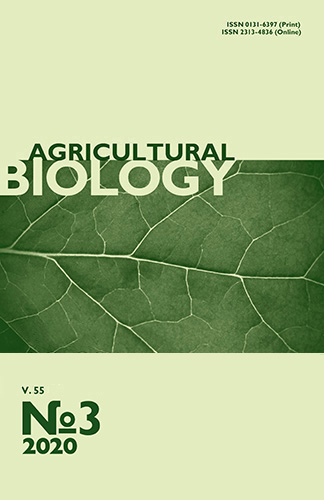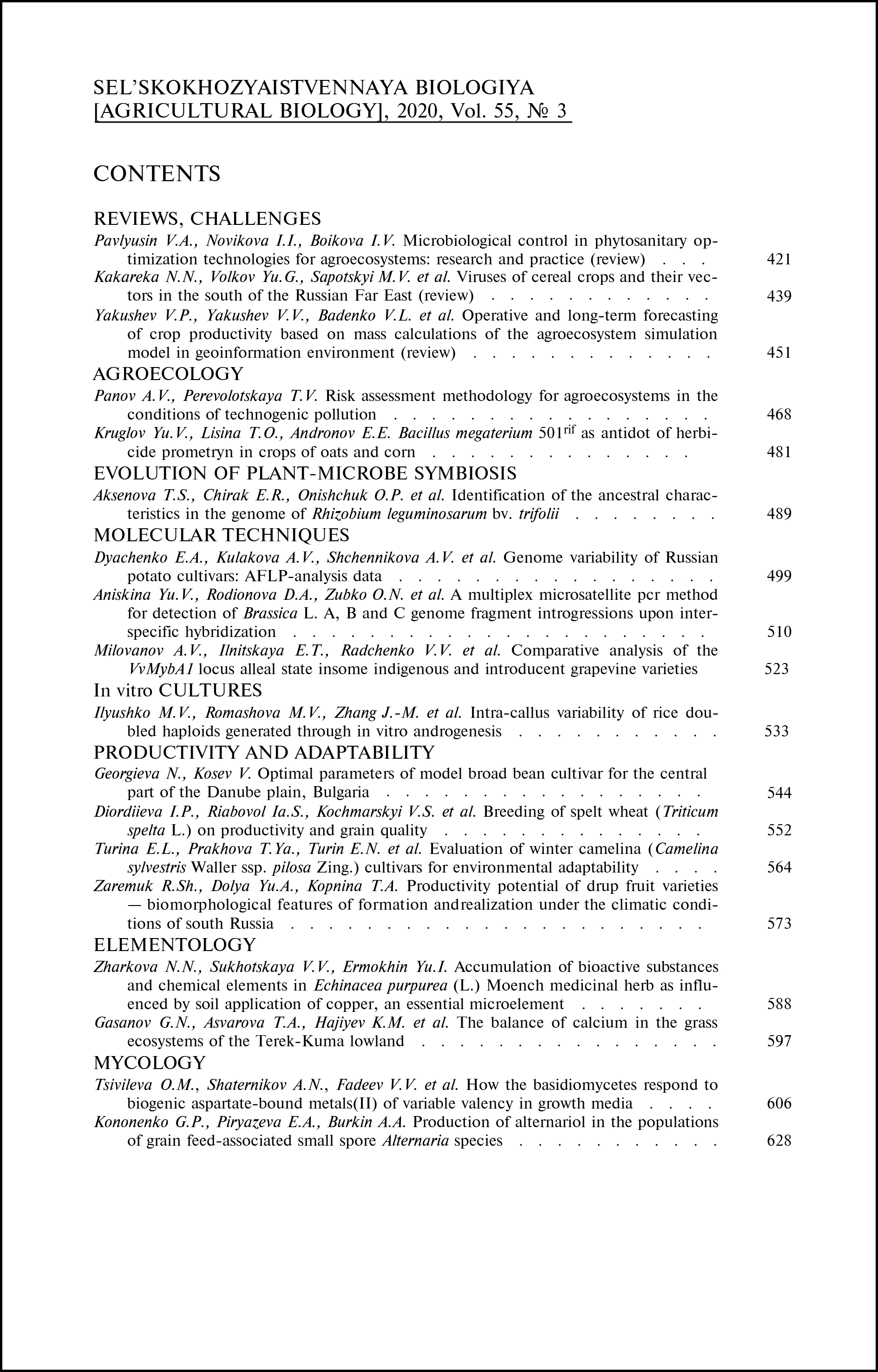doi: 10.15389/agrobiology.2020.3.489eng
UDC: 631.461.52:575.22:575.85
Acknowledgements:
Supported financially by Russian Foundation for Basic Research, the project No. 18-34-00839 (collection of nodules and isolation of strains), and Russian Science Foundation, the project No. 19-16-00081 (genome sequencing and bioinformatics data analysis)
IDENTIFICATION OF THE ANCESTRAL CHARACTERISTICS IN THE GENOME OF Rhizobium leguminosarum bv. trifolii
T.S. Aksenova1, E.R. Chirak1, O.P. Onishchuk1, O.N. Kurchak1, A.M. Afonin1, A.G. Pinaev1, E.E. Andronov1, 2, 3, N.A. Provorov1
1All-Russian Research Institute for Agricultural Microbiology, 3, sh. Podbel’skogo, St. Petersburg, 196608 Russia, e-mail tsaksenova@mail.ru, chirak.elizaveta@gmail.com, olony@yandex.ru, okurchak@yahoo.com, aafonin@arriam.ru, agpinaev@gmail.com, eeandr@gmail.com (✉ corresponding author), provorovnik@ya.ru;
2Dokuchaev Soil Science Institute, 7/str. 2, Pyzhyovskii per., Moscow, 119017 Russia;
3Saint-Petersburg State University, 7-9, Universitetskaya nab., St. Petersburg, 199034 Russia
ORCID:
Aksenova T.S. orcid.org/0000-0002-7294-8410
Afonin A.M. orcid.org/0000-0002-8530-0226
Chirak E.R. orcid.org/0000-0002-1610-8935
Pinaev A.G. orcid.org/0000-0001-8272-9679
Onishchuk O.P. orcid.org/0000-0002-5378-7826
Andronov E.E. orcid.org/0000-0002-5204-262X
Kurchak O.N. orcid.org/0000-0003-3555-7426
Provorov N.A. orcid.org/0000-0001-9091-9384
Received March 12, 2020
Nodule bacteria of the species Rhizobium leguminosarum are symbiotic N2-fixers that divide into two biotypes: viciae and trifolii (D.C Jordan. et al., 1984). Symbiotic genes, the evolution of which depends on host plants, are responsible for the function of symbiotic nitrogen fixation (J.P.W. Young et al., 1989). Recently it was shown that according to the type of organization of the symbiotic regions of the genomes, rhizobia isolated from the Vavilovia formosa (Stev.) Fed.are close to the protosymbiont of the tribe Fabeae R. leguminosarum bv. viceae (E.R. Chirak et al., 2019). However, in the evolution of R. leguminosarum, there was another earlier divergence between the biotypes viceae and trifolii, the starting point of which was the protosymbiont of the entire species R. leguminosarum, which existed before its separation into biovars. In this work we present the results of genomes sequencing of a group of Rhizobium leguminosarum bv. trifolii and comparisons of the structure of their symbiotic regions with the corresponding regions of the genomes of Rhizobium leguminosarum bv. viciae, related to the ancestral and “advanced” types. In the program CLC Genomics Workbench 7.5.1, we compared the obtained genome-wide sequences of the strains R. leguminosarum bv. trifolii (Oxford Nanopore sequencing technique) with reference strains of R. leguminosarum bv. viceae, related to ancestral and “advanced” types. It was shown that in the genomes of strains of clover symbionts, four of five ancestral characters are found: an increased size of intergenic regions in the symbiotic region, the presence of the nodX gene in the nod-operon, the absence of the nodT gene in the sym-region, and only one copy of the fixNOPQ operon located on the pSym. Based on the results obtained, we suggest that the protosymbiont R. leguminosarum could be close to clover rhizobia.
Keywords: Rhizobium leguminosarum bv. trifolii, symbiosis evolution, symbiotic genes, protosymbiont, genome-wide sequences.
REFERENCES
- Jordan D.C. Family III. Rhizobiaceae. In: Bergey’s manual of systematic bacteriology. N.R. Krieg, J.G. Holt (eds.). Williams and Wilkins, Baltimore, 1984: 234-242.
- Young J.P.W., Johnston A.W.B. The evolution of specificity in the legume-rhizobium symbiosis. Trends in Ecology & Evolution, 1989, 4(11): 341-349 CrossRef
- Göttfert M. Regulation and function of rhizobial nodulation genes. FEMS Microbiology Reviews, 1993, 10(1-2): 39-63 CrossRef
- Debellé F., Moulin L., Mangin B., Dénarié J., Boivin C. Nod genes and Nod signals and the evolution of the Rhizobium legume symbiosis. Acta Biochimica Polonica, 2001, 48(2): 359-365. CrossRef
- Shamseldin A. The role of different genes involved in symbiotic nitrogen fixation. Global Journal of Biotechnology & Biochemistry, 2013, 8(4): 84-94 CrossRef
- Fischer H.M. Genetic regulation of nitrogen fixation in rhizobia. Microbiological Reviews, 1994, 58(3): 352-386.
- Provorov N.A., Andronov E.E. Evolution of root nodule bacteria: reconstruction of the speciation processes resulting from genomic rearrangements in a symbiotic system. Microbiology, 2016, 85: 131-139 CrossRef
- Rey F.E., Harwood C.S. FixK, a global regulator of microaerobic growth, controls photosynthesis in Rhodopseudomonas palustris. Molecular Microbiology, 2010, 75(4): 1007-1020 CrossRef
- Wongdee J., Boonkerd N., Teaumroong N., Tittabutr P., Giraud E. Regulation of nitrogen fixation in Bradyrhizobium sp. strain DOA9 involves two distinct NifA regulatory proteins that are functionally redundant during symbiosis but not during free-living growth. Frontiers in Microbiology, 2018, 9: 1644 CrossRef
- Chirak E.R., Kimeklis A.K., Karasev E.S., Kopat V.V., Safronova V.I., Belimov A.A., Aksenova T.S., Kabilov M.R., Provorov N.A., Andronov E.E. Search for ancestral features in genomes of Rhizobium leguminosarum bv. Viciae strains isolated from the relict legume Vavilovia formosa. Genes, 2019, 10(12): 990 CrossRef
- Mikič A., Smýkal P., Kenicer G., Vishnyakova M., Sarukhanyan N., Akopian J., Vanyan A., Gabrielyan I., Smýkalová I., Sherbakova E., Zorić L., Atlagić J., Zeremski-Škorić T., Ćupina B., Krstić Ð., Jajić I., Antanasović S., Ðorđević V., Mihailović V., Ivanov A., Ochatt S., Ambrose M. The bicentenary of the research on ‘beautiful’ vavilovia (Vavilovia formosa), a legume crop wild relative with taxonomic and agronomic potential. Bot. J. Linn. Soc., 2013, 172(4): 524-531 CrossRef
- Biologicheskoe raznoobrazie kluben'kovykh bakterii v ekosistemakh i agrotsenozakh. Teoreticheskie osnovy i metody (monografiya) /Pod redaktsiei M.L. Rumyantsevoi, B.V. Simarova The biological diversity of nodule bacteria in ecosystems and agrocenoses. Theoretical foundations and methods (a monograph). M.L. Rumyantseva, B.V. Simarova (eds.)]. St. Petersburg, 2011 (in Russ.).
- Somasegaran P., Hoben H.J. Isolating and purifying genomic DNA of Rhizobia using a large-scale method. In: Handbook for Rhizobia: methods in legume-rhizobium technology. Springer, New York, 1994: 279-283 CrossRef
- Wick R.R., Judd L.M., Holt K.E. Deepbinner: Demultiplexing barcoded Oxford Nanopore reads with deep convolutional neural networks. PLoS Computational Biology, 2018, 14(11): e1006583 CrossRef
- Seemann T. Prokka: rapid prokaryotic genome annotation. Bioinformatics, 2014, 30(14): 2068-2069 CrossRef
- Reeve W., Ardley J., Tian R., Eshragi L., Yoon J.W., Ngamwisetkun P., Seshadri R., Ivanova N.N., Kyrpides N.C. A genomic encyclopedia of the root nodule bacteria: assessing genetic diversity through a systematic biogeographic survey. Standards in Genomic Sciences, 2015, 10: 14 CrossRef
- Terpolilli J., Rui T., Yates R., Howieson J., Poole P., Munk C., Tapia R., Han C., Markowitz V., Tatiparthi R., Mavrommatis K., Ivanova N., Pati A., Goodwin L., Woyke T., Kyrpides N., Reeve W. Genome sequence of Rhizobium leguminosarum bv. trifolii strain WSM1689, the microsymbiont of the one flowered clover Trifolium uniflorum. Standards in Genomic Sciences, 2013, 9: 527-539 CrossRef
- Kumar S., Stecher G., Li M., Knyaz C., Tamura K. MEGA X: molecular evolutionary genetics analysis across computing platforms. Molecular Biology and Evolution, 2018, 35(6): 1547-1549 CrossRef
- Guindon S., Dufayard J.F., Lefort V., Anisimova M., Hordijk W., Gascuel O. New algorithms and methods to estimate maximum-likelihood phylogenies: assessing the performance of PhyML 3.0. Systematic Biology, 2010, 59(3): 307-321 CrossRef
- Schwarz G. Estimating the dimension of a model. Annals of Statistics, 1978,6(2): 461-464 CrossRef
- Letunic I., Bork P. Interactive tree of life (iTOL) v3: an online tool for the display and annotation of phylogenetic and other trees. Nucleic Acids Research, 2016, 44(W1): W242-W245 CrossRef
- Safronova V.I., Kimeklis A.K., Chizhevskaya E.P., Belimov A.A., Andronov E.E., Pinaev A.G., Pukhaev A.R., Popov K.P., Tikhonovich I.A. Genetic diversity of rhizobia isolated from nodules of the relic species Vavilovia formosa (Stev.). Fed. Antonie van Leeuwenhoek, 2014, 105: 389-399 CrossRef
- Makasheva R.Kh., Drozd A.M., Adamova O.P., Golubev A.A. Sbornik trudov po prikladnoi botanike, genetike i selektsii, 1973, 51(1): 44 (in Russ.).
- Ma S.W., Iyer V.N. New field isolates of Rhizobium leguminosarum biovar Viciae that nodulate the primitive pea cultivar Afghanistan in addition to modern cultivars. Applied and Environmental Microbiology, 1990, 56(7): 2206-2212.
- Kimeklis A.K., Chirak E.R., Kuznetsova I.G., Sazanova A.L., Safronova V.I., Belimov A.A., Onishchuk O.P., Kurchak O.N., Aksenova T.S., Pinaev A.G., Andronov E.E., Provorov N.A. Rhizobia isolated from the relict legume Vavilovia Formosa represent a genetically specific group within Rhizobium leguminosarum biovar viciae. Genes, 2019, 10(12): 991 CrossRef
- Provorov N., Tikhonovich I. Genetic resources for improving nitrogen fixation in legume-rhizobia symbiosis. Genetic Resources and Crop Evolution, 2003, 50: 89-99 CrossRef
- Alvarez-Ortega C., Olivares J., Martínez J.L. RND multidrug efflux pumps: What are they good for? Frontiers in Microbiology, 2013, 4: 7 CrossRef
- Hontelez J.G., Lankhorst R.K., Katinakis P., van den Bos R.C., van Kammen A. Characterization and nucleotide sequence of a novel gene fixW upstream of the fixABC operon in Rhizobium leguminosarum. Mol. Gen. Genet., 1989,218: 536-544 CrossRef
- Talbi C., Sanchez C., Hidalgo-Garcia A., González E.M., Arrese-Igor C., Girard L., Bedmar E.J., Delgado M.J. Enhanced expression of Rhizobium etli cbb3 oxidase improves drought tolerance of common bean symbiotic nitrogen fixation. Journal of Experimental Botany,2012, 63(14): 5035-5043 CrossRef
- Kopat V.V., Chirak E.R., Kimeklis A.K., Safronova V.I., Belimov A.A., Kabilov M.R., Andronov E.E., Provorov N.A. Evolution of fixNOQP genes encoding cytochrome oxidase with high affinity to oxygen in Rhizobia and related bacteria. Russ. J. Genet., 2017, 53: 766-774 CrossRef
- Berrada H., Fikri-Benbrahim K. Taxonomy of the rhizobia: current perspectives. British Microbiology Research Journal, 2014, 4(6): 616-639 CrossRef












